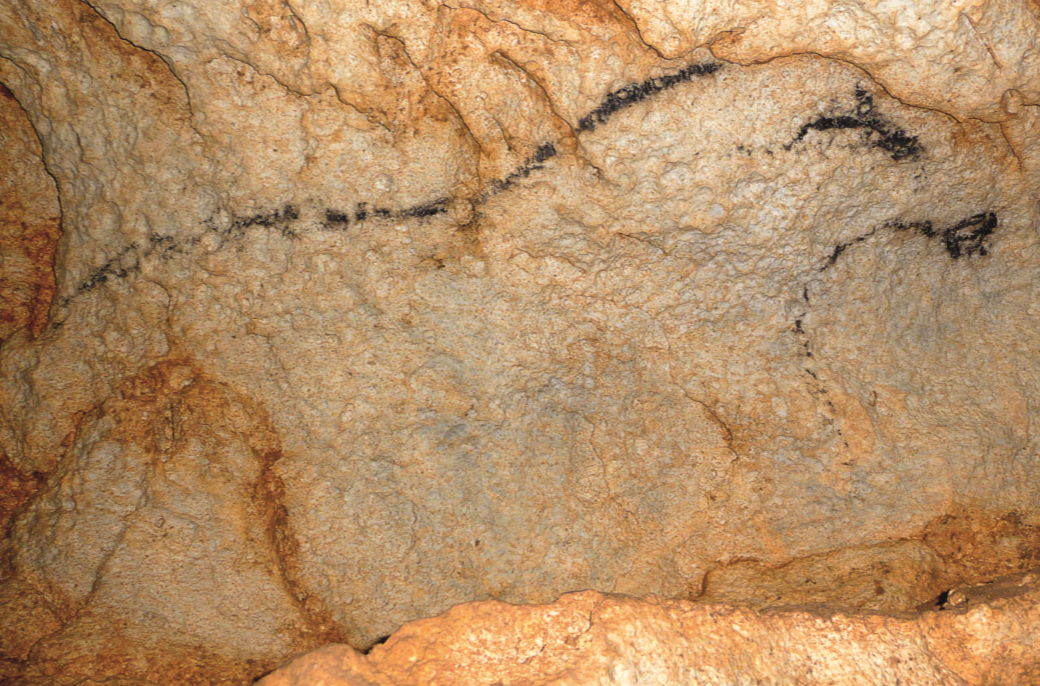


In an article by Ellie Zolfagharifard in MailOnline - Footprints of a 36,000-year-old family discovered: Romanian cave found to hold some of Europe's oldest ever human tracks - the author describes how a new analysis by archaeologists in Romania's Carpathian Mountains has possibly revealed some of Europe's oldest human footprints, in the cave of Ciur-Izbuc.

Coliboaia cave. Photo: Jean Clottes
In 1965 the cave was first explored, when approximately 400 footprints were discovered. These were thought to date from 10,000 to 15,000 years ago. The recent analysis in the cave - radiocarbon dating of two cave bear fossils excavated below the footprints - may prove the footprints are much older; the researchers are suggesting as much as 36,500 years, claiming them to be Europe's oldest human footprints. Their research is presented in the American Journal of Physical Anthropology. Further analysis is planned, such as detailed three-dimensional mapping of the footprints.
Whilst this evidence is not yet conclusive, other archaeological projects in Romania are revealing much older dates than previously thought for human occupation as well as for rock art. An account of the discovery of paintings in the Coliboaia cave in the Natural Park of Mounts Apuseni, department of Bihor was published in INORA 61, 2011.
A French team, including two spelunkers (Marcel Meyssonnier and Valerie Plichon), a paleontologist who is a specialist of cave bears (Michel Phlippe), a prehistorian (Francoise Prudhomme) and two specialists of cave art (Jean Clottes and Bernard Gely), studied the paintings in 2010. They established their authenticity.
From the themes represented and the appearance of the painted animals, the initial hypothesis proposed for the dating of the drawings from seeing the first photographs was that they belonged to an ancient period of cave art, such as the Gravettian or the Aurignacian (i.e. between 25,000 and 35,000 BP). Radiocarbon dating has produced two very ancient dates - one from an animal bone is almost 32,000 years old, and one from a fragment charcoal is almost 37,000 years old.
With the Coliboaia dates a commonality of cultural practices, and probably of beliefs, from those very early times all over Europe is now apparent.
http://www.bradshawfoundation.com/ishop/inora.php
by Bradshaw Foundation
Wednesday 23 July 2025
by Bradshaw Foundation
Thursday 29 May 2025
by Bradshaw Foundation
Monday 03 February 2025
by Bradshaw Foundation
Monday 30 May 2022
by Bradshaw Foundation
Wednesday 19 January 2022
by Bradshaw Foundation
Thursday 06 January 2022
by Bradshaw Foundation
Tuesday 21 March 2023
by Bradshaw Foundation
Tuesday 07 February 2023
by Bradshaw Foundation
Thursday 19 May 2022
by Bradshaw Foundation
Monday 04 December 2023
by Bradshaw Foundation
Friday 30 June 2023
by Bradshaw Foundation
Thursday 06 April 2023
by Bradshaw Foundation
Friday 14 July 2023
by Bradshaw Foundation
Monday 22 November 2021
by Bradshaw Foundation
Tuesday 12 July 2016
by Bradshaw Foundation
Tuesday 26 November 2024
by Bradshaw Foundation
Monday 27 November 2023
by Bradshaw Foundation
Friday 07 October 2022
by Bradshaw Foundation
Wednesday 23 July 2025
by Bradshaw Foundation
Thursday 29 May 2025
by Bradshaw Foundation
Monday 03 February 2025
by Bradshaw Foundation
Monday 30 May 2022
by Bradshaw Foundation
Wednesday 19 January 2022
by Bradshaw Foundation
Thursday 06 January 2022
by Bradshaw Foundation
Tuesday 21 March 2023
by Bradshaw Foundation
Tuesday 07 February 2023
by Bradshaw Foundation
Thursday 19 May 2022
by Bradshaw Foundation
Monday 04 December 2023
by Bradshaw Foundation
Friday 30 June 2023
by Bradshaw Foundation
Thursday 06 April 2023
by Bradshaw Foundation
Friday 14 July 2023
by Bradshaw Foundation
Monday 22 November 2021
by Bradshaw Foundation
Tuesday 12 July 2016
by Bradshaw Foundation
Tuesday 26 November 2024
by Bradshaw Foundation
Monday 27 November 2023
by Bradshaw Foundation
Friday 07 October 2022
by Bradshaw Foundation
Tuesday 19 November 2024
by Bradshaw Foundation
Wednesday 22 May 2024
by Bradshaw Foundation
Friday 10 November 2023
Friend of the Foundation











